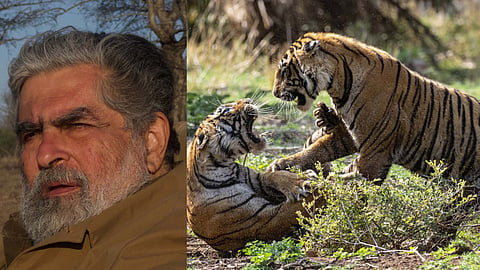

Legendary Tigers of India documentary review:
The new documentary Legendary Tigers of India from BBC Studios follows a group of tigers at the Ranthambore Tiger Reserve in Rajasthan over a long period while exploring their significance in the context of a depleting population of the wild cats in India. A writer, filmmaker, and conservationist, the late Valmik Thapar tracks the health and status of the tigers as they face possible extinction, with poachers posing a threat to their lives on a regular basis. Valmik Thapar presents the documentary compellingly, giving us tidbits of information about the day-to-day activity of tigers at the reserve and lending human-like qualities to the wild cats with his narration. For example, when the film establishes that Valmik Thapar goes to Ranthambore to get away from his crumbling marital life, you empathise with him. And when he describes himself as just a “filmmaker who fell in love with the beauty of this place and with its tigers,” you realise that this is a man with an unusual ambition for the big cats and you fall for the sheer gravitas in his voice. As a result, at the end of the 50-minute documentary, you start to feel some sort of connection with these animals, although it hardly ever tries to tug at your heartstrings in the same way real-life stories tend to. In terms of presentation, the documentary reminds you of A Lion Called Christian as it follows the frictions among the tigers as well as between the big cats and poachers. The passage about one of the tigers trying to ambush another’s mother and the latter’s cubs to own that territory provides a fascinating peek into the primal ways in which the animals operate in the jungle.
That being said, Legendary Tigers of India does not have the same personal angle as the story of a man reuniting with his lion pet named Christian after many years. It has a broader focus, with Valmik Thapar serving as a champion for a separate cause: one for the National Animal of India. He bats for rules against tiger poaching, and his journey as a staunch advocate for tiger protection spans multiple decades, from the 1970s mid to the early 2010s. It is remarkable that this man had dedicated a good part of his life mainly to look after the entire population of tigers at the reserve, despite the lack of a personal and face-to-face connection with them. At one point, he takes the initiative to ensure that poachers do not get to the tigers and harm them.
Presenter: Valmik Thapar
Directors: Mike Birkhead, Beth Jones
Producers: Mike Birkhead, Beth Jones
Streamers: BBC Player on Tata Play Binge, Prime Video
Legendary Tigers of India does not use any artificial effects to heighten the impact of wildlife encounters. This is as raw a look at wildlife as you can find online, conveying a message in favour of tiger conservation in bold letters. A moment where a tiger runs into a lake and attacks a Sambar deer is filmed with such urgency that you feel like you are in the moment. The filmmaking also ensures that we get an immersive look at the reserve, with tracking shots and time-lapses taking us deep into the jungle while depicting its diverse group of animals, flora and fauna in all their glory. The documentary also goes a long way towards banishing any stereotype that exists about tigers as mere predators. Thankfully, it is not bound by the constraints of commercial storytelling, where filmmakers must portray tigers as some forms of predatory antagonists to fit them into their fictional universes. The documentary portrays tiger poaching in all its grim reality, making us pause a moment and reflect on the horrific crime that has been taking place in India before independence. As Valmik explains in his loud and deep voice, Europeans and Indian Kings themselves had poached hundreds of tigers. One of the emperors had even boasted about killing thousands of them, whereas the Duke of Edinburgh and Queen Elizabeth had shot tigers at the reserve.
In the 1970s, when the Indira Gandhi-led government banned tiger hunting and about the time Valmik set off to Ranthambore, there were 1800 wild tigers in the country. Now, according to a recent study featured in the peer-reviewed journal Science, the estimated number is twofold, making India home to 75 per cent of the tiger population in the world. It is a testament to the role of conservationists such as Valmik in protecting these mighty carnivores. But then again, the documentary does not make any such claim about the efforts from the people behind it. The film is all about depicting the truth, which is partly what makes it a compelling clarion call.